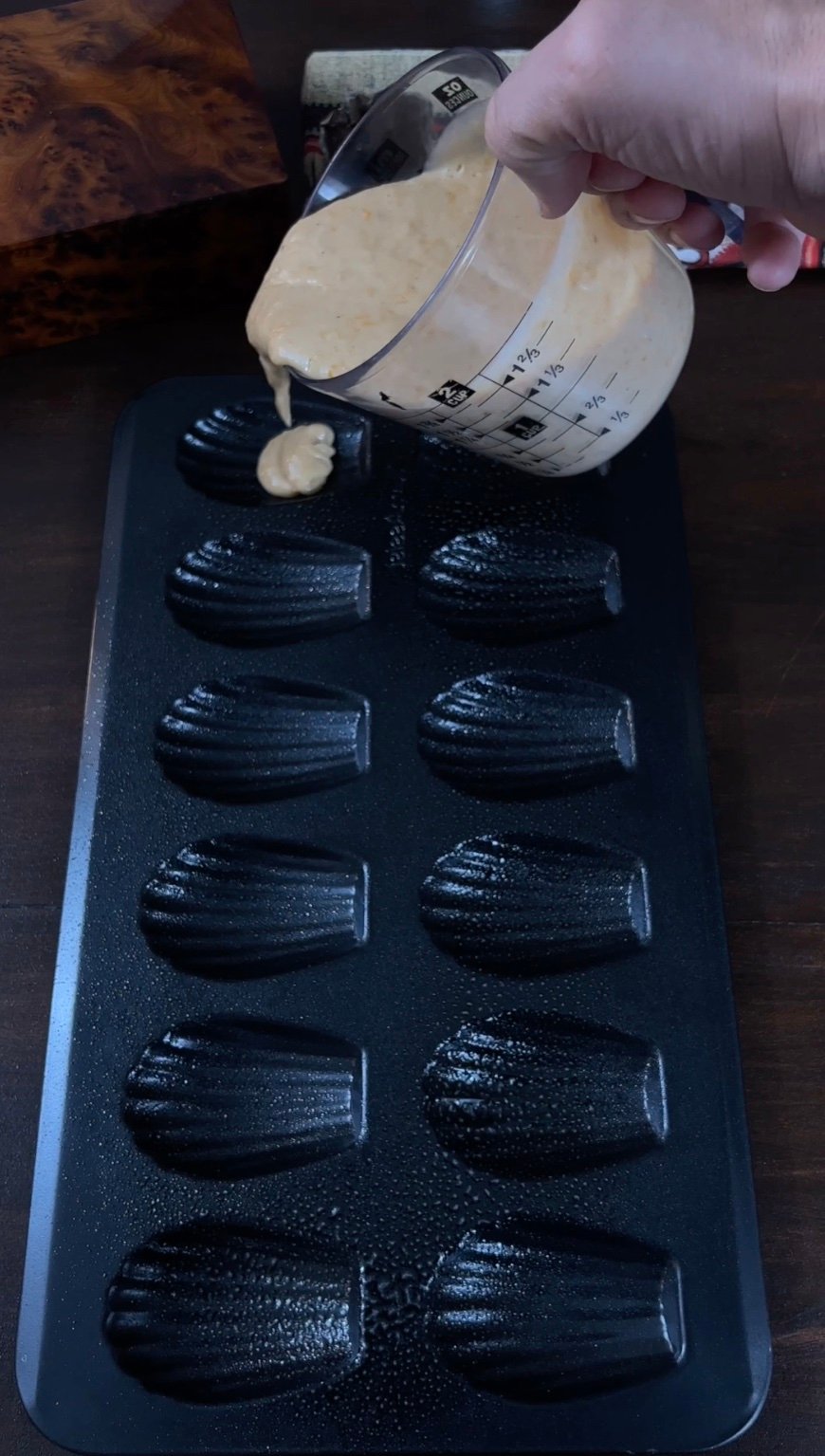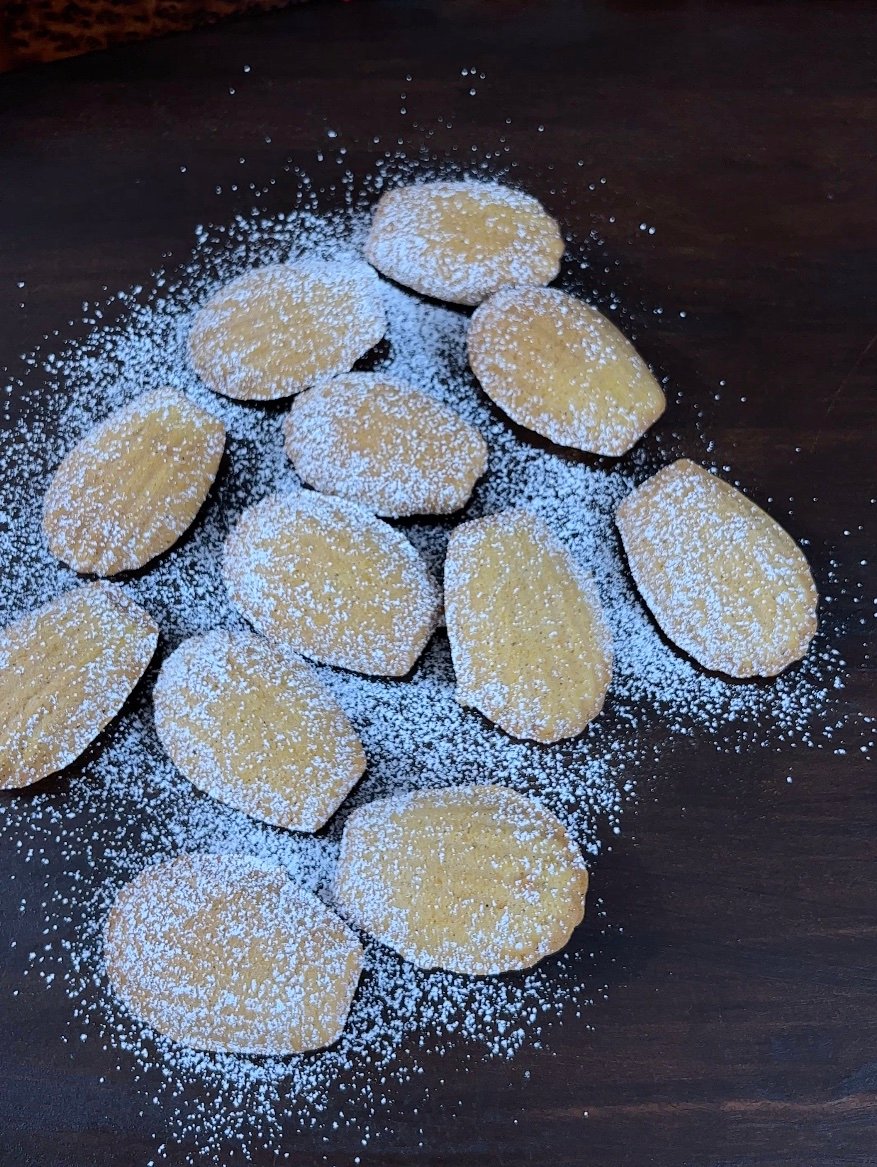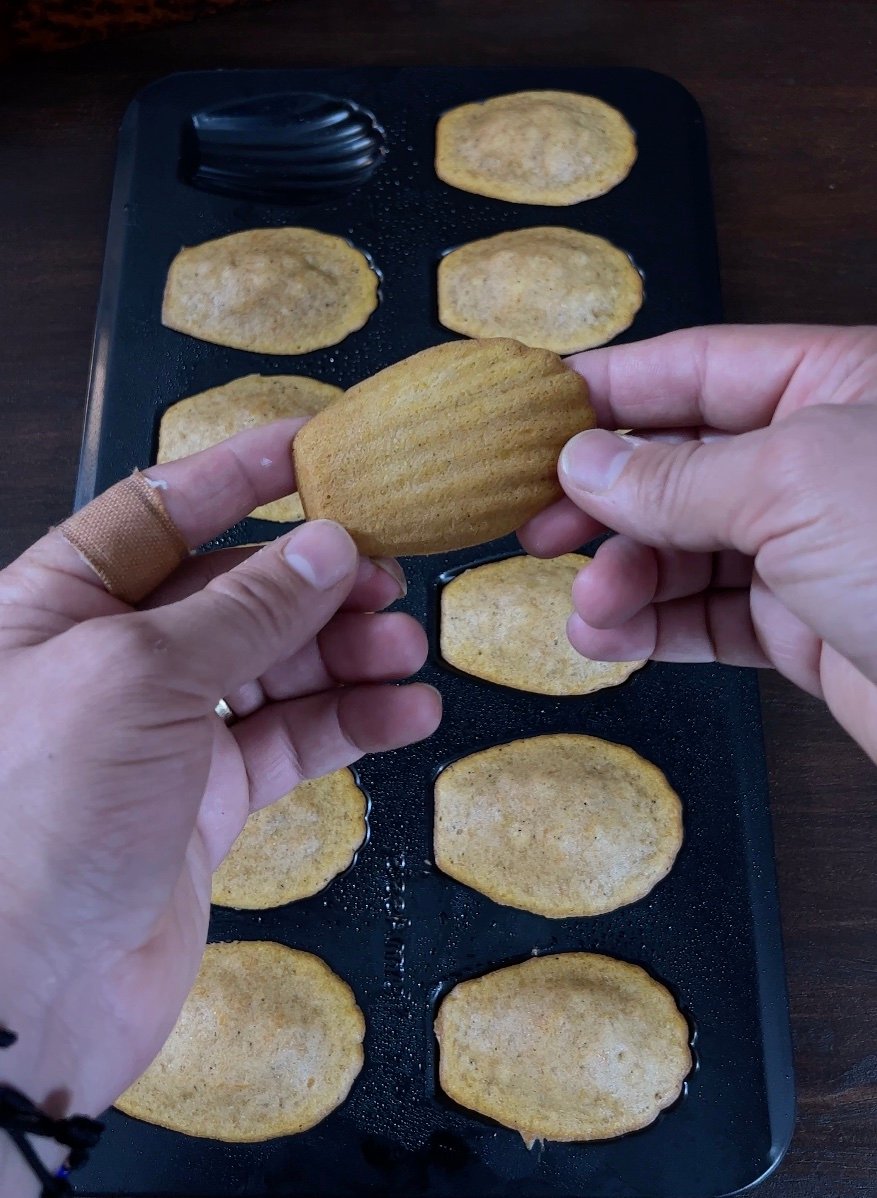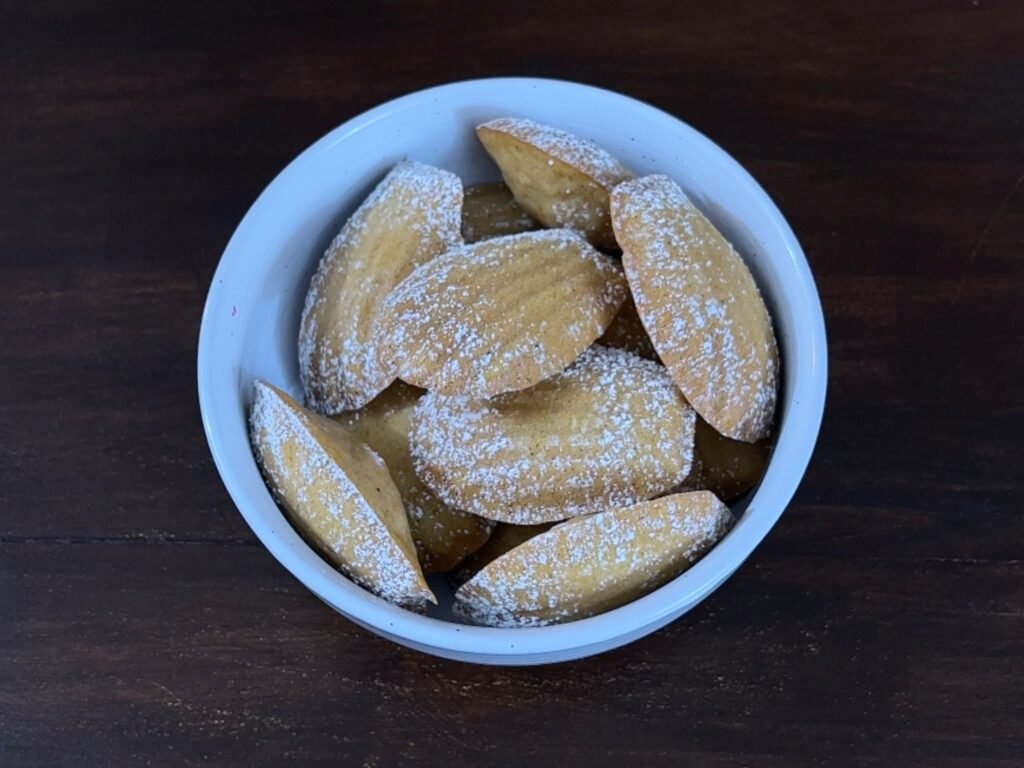No products in the cart.
Classic French Madeleines
History and significance of French Madeleines
Madeleines, those delicate shell-shaped cakes, have a rich history and a significant place in French culinary tradition. These little treats are believed to have originated in the Lorraine region of France in the 18th century. The name “Madeleine” is said to be derived from a young girl named Madeleine Paulmier, who worked as a cook for the Duke of Lorraine. Legend has it that she created these cakes for the Duke, and they became an instant hit among the aristocracy.
Madeleines hold a special place in French literature as well. In Marcel Proust’s famous novel “Remembrance of Things Past,” the protagonist’s involuntary memory is triggered by the taste of a Madeleine dipped in tea. This literary reference has further elevated the status of Madeleines as a symbol of nostalgia and sensory pleasure.
Traditional French Madeleine recipe
To truly experience the magic of Madeleines, it is essential to have a go-to recipe that captures the essence of these delicate cakes. Here is a traditional French Madeleine recipe that will transport you to the streets of Paris with every bite:
Ingredients: – 3 large eggs – 1/2 cup granulated sugar – 1 cup all-purpose flour – 1/2 teaspoon baking powder – 8 tablespoons unsalted butter, melted and cooled – 1 teaspoon vanilla extract – Powdered sugar, for dusting
Instructions: 1. In a mixing bowl, whisk together the eggs and granulated sugar until pale and fluffy. 2. In a separate bowl, combine the flour and baking powder. 3. Gradually add the dry ingredients to the egg mixture, folding gently until just combined. 4. Slowly pour in the melted butter and vanilla extract, stirring until the batter is smooth. 5. Cover the bowl with plastic wrap and refrigerate for at least 1 hour, or overnight for best results. 6. Preheat your oven to 375°F (190°C) and grease a Madeleine pan with butter or cooking spray. 7. Spoon the chilled batter into the prepared Madeleine pan, filling each shell-shaped cavity about three-fourths full. 8. Bake for 10-12 minutes, or until the edges of the Madeleines are golden brown and the centers are springy to the touch. 9. Remove from the oven and let the Madeleines cool in the pan for a few minutes before transferring them to a wire rack to cool completely. 10. Dust with powdered sugar before serving.
Tips for making perfect French Madeleines
While the traditional Madeleine recipe is relatively simple, there are a few tips and tricks that can help you achieve the perfect texture and flavor:
- Chill the batter: Allowing the batter to rest in the refrigerator for at least an hour before baking is crucial. This step helps the Madeleines develop their signature hump and ensures a light and airy texture.
- Preheat the Madeleine pan: It’s essential to preheat the Madeleine pan before spooning in the batter. This step helps create the characteristic crisp edges of the cakes.
- Use room temperature eggs: Make sure your eggs are at room temperature before whisking them with the sugar. This ensures better emulsification and a smoother batter.
- Don’t overmix: When incorporating the dry ingredients into the egg mixture, be careful not to overmix. Overmixing can lead to dense Madeleines instead of the desired light and fluffy texture.
- Experiment with flavors: While the traditional vanilla Madeleine is delightful on its own, don’t be afraid to experiment with different flavor variations. Add lemon zest for a refreshing twist, cocoa powder for a chocolatey indulgence, or matcha powder for a touch of elegance.


Classic French Kabocha Madeleine
Print Recipe Pin RecipeMadeleines, those delicate shell-shaped cakes, have a rich history and a significant place in French culinary tradition! I used Kabocha to make these Madeleine and it's incredible!
Kitchen equipment list
- 1 Bellemain Madeleine Pan
Ingredients
- 2 cups All-purpose flour
- 1 tsp Baking powder
- 1 tsp Baking soda
- ½ tsp Salt
- ½ cup Unsalted butter
- ½ cup Brown sugar
- ½ cup Granulated sugar
- 1 large Eggs
- 1 cup Kabocha Pumpkin cooked and pureed
- 1 tsp Vanilla extract
- 1 tbsp Pumpkin pie spice
Instructions
- Preheat your oven to 375°F (190°C). Grease and flour your Madeleine molds or use a non-stick Madeleine pan.
- In a small saucepan, melt the butter over low heat. Once melted, remove from heat and let it cool to room temperature.
- In a mixing bowl, sift together the flour, baking powder, and salt. Set aside.
- In another bowl, using an electric mixer, beat the eggs, granulated sugar, and vanilla extract together until the mixture is pale and fluffy. This usually takes about 5 minutes.
- Add the Kabocha and mix for another 2 minutes
- Gently fold the sifted dry ingredients into the egg mixture in two or three additions. Be careful not to overmix; just fold until the ingredients are combined.
- Pour the melted and cooled butter over the batter and fold it in until well combined. If you're using lemon zest, add it at this stage and fold it in as well.
- Cover the batter and refrigerate it for at least 30 minutes. Chilling the batter helps the Madeleines achieve their distinctive hump.
- Spoon the batter into the prepared Madeleine molds, filling each about 3/4 full.
- Bake in the preheated oven for 10-12 minutes or until the edges are golden brown and the centers spring back when lightly touched.
- Remove the Madeleines from the oven and let them cool in the pan for a few minutes. Then, transfer them to a wire rack to cool completely.
- Optional: Dust the cooled Madeleines with powdered sugar before serving.
- Enjoy your homemade French Madeleines with a cup of tea or coffee!
❋ Kitchen Chaos Unlocked Tips
Tips for making perfect French Madeleines
While the traditional Madeleine recipe is relatively simple, there are a few tips and tricks that can help you achieve the perfect texture and flavor:- Chill the batter: Allowing the batter to rest in the refrigerator for at least an hour before baking is crucial. This step helps the Madeleines develop their signature hump and ensures a light and airy texture.
- Preheat the Madeleine pan: It's essential to preheat the Madeleine pan before spooning in the batter. This step helps create the characteristic crisp edges of the cakes.
- Use room temperature eggs: Make sure your eggs are at room temperature before whisking them with the sugar. This ensures better emulsification and a smoother batter.
- Don't overmix: When incorporating the dry ingredients into the egg mixture, be careful not to overmix. Overmixing can lead to dense Madeleines instead of the desired light and fluffy texture.
- Experiment with flavors: While the traditional vanilla Madeleine is delightful on its own, don't be afraid to experiment with different flavor variations. Add lemon zest for a refreshing twist, cocoa powder for a chocolatey indulgence, or matcha powder for a touch of elegance.
Nutrition
Serving: 28 gCalories: 115 kcalCarbohydrates: 13 gProtein: 1.5 gFat: 6.5 gSaturated Fat: 3.9 gPolyunsaturated Fat: 0.4 gMonounsaturated Fat: 1.8 gCholesterol: 39 mgFiber: 0.2 g
Tried this recipe? Mention @KitchenChaosUnlocked or tag #KitchenChaosUnlocked!
Variations and flavor combinations for French Madeleines
One of the many charms of Madeleines is their versatility. You can easily adapt the basic recipe to create a variety of flavors and combinations. Here are a few ideas to inspire your culinary creativity:
- Lemon Madeleines: Add the zest of one lemon to the batter for a bright and citrusy twist. You can also drizzle the finished Madeleines with a lemon glaze for an extra burst of flavor.
- Chocolate Madeleines: Replace 2 tablespoons of flour with unsweetened cocoa powder and fold in some chopped dark chocolate for a decadent chocolate experience.
- Matcha Madeleines: Sift in 2 teaspoons of matcha powder with the dry ingredients to infuse your Madeleines with a delicate green tea flavor. Dust with powdered sugar or matcha powder for an elegant finish.
- Almond Madeleines: Add a teaspoon of almond extract to the batter and sprinkle slivered almonds on top before baking for a nutty twist.
- Orange Blossom Madeleines: Substitute the vanilla extract with a teaspoon of orange blossom water for a delicate floral flavor.
Feel free to explore different combinations and experiment with your favorite flavors. The possibilities are endless when it comes to Madeleines!
Serving suggestions and accompaniments for French Madeleines
Madeleines are delightful on their own, but they can also be enhanced with various accompaniments and serving suggestions. Here are a few ideas to elevate your Madeleine experience:
- Dipping sauces: Serve warm Madeleines with a side of melted chocolate, caramel sauce, or fruit compote for dipping. This adds an extra layer of indulgence and flavor.
- Whipped cream or crème fraîche: Top your Madeleines with a dollop of lightly sweetened whipped cream or tangy crème fraîche for a creamy and decadent treat.
- Fresh berries: Arrange a handful of fresh berries, such as raspberries or strawberries, alongside your Madeleines for a burst of freshness and color.
- Tea or coffee: Enjoy your Madeleines with a cup of hot tea or coffee for a classic French experience. The gentle sweetness and delicate flavors of the cakes pair perfectly with a warm beverage.
Step-by-step guide to baking French Madeleines
If you’re new to baking Madeleines, fear not! We’ve got you covered with a step-by-step guide to help you navigate the process with ease:
- Gather all the ingredients and equipment needed, including a Madeleine pan.
- Follow the traditional French Madeleine recipe mentioned earlier, whisking together the eggs and sugar, adding the dry ingredients, and folding in the melted butter and vanilla extract.
- Cover the bowl with plastic wrap and refrigerate the batter for the recommended time.
- Preheat your oven to the specified temperature and grease the Madeleine pan.
- Spoon the chilled batter into the prepared pan, filling each shell-shaped cavity about three-fourths full.
- Place the pan in the preheated oven and set the timer for the recommended baking time.
- While the Madeleines are baking, prepare any accompaniments or dipping sauces you plan to serve.
- Once the Madeleines are done, remove them from the oven and let them cool in the pan for a few minutes.
- Transfer the Madeleines to a wire rack to cool completely.
- Dust with powdered sugar or any other desired topping before serving.
Troubleshooting common issues when making French Madeleines
Even experienced bakers encounter challenges when making Madeleines. Here are some common issues and their solutions:
- Flat Madeleines: If your Madeleines didn’t develop the characteristic hump, it could be due to insufficient chilling time or overmixing the batter. Make sure to refrigerate the batter for the recommended time and fold the ingredients together gently.
- Stuck Madeleines: If your Madeleines are sticking to the pan, try greasing it more thoroughly or using a non-stick pan. You can also dust the pan with flour or cocoa powder for additional insurance against sticking.
- Dry Madeleines: Overbaking can result in dry Madeleines. Keep a close eye on the baking time and remove the cakes from the oven as soon as the edges are golden and the centers are springy to the touch.
- Uneven browning: Uneven browning could be a result of variations in oven temperature or improper distribution of the batter in the pan. Make sure your oven is properly calibrated and spoon the batter evenly into each cavity.
French Madeleines vs other popular French pastries
French cuisine is renowned for its wide variety of pastries and desserts. While Madeleines have their special place, let’s explore how they compare to other popular French pastries:
- Croissants: Croissants are flaky, buttery pastries with a crescent shape. Unlike Madeleines, which are cake-like, croissants have a laminated dough made with layers of butter that create their distinctive texture.
- Macarons: Macarons are delicate meringue-based cookies sandwiched together with a creamy filling. Madeleines, on the other hand, are single, shell-shaped cakes with a more substantial texture.
- Éclairs: Éclairs are elongated pastries filled with cream and topped with chocolate or icing. Unlike Madeleines, which are bite-sized and delicate, éclairs are larger and more substantial.
- Tarte Tatin: Tarte Tatin is an upside-down caramelized apple tart. Madeleines, on the other hand, are individual cakes with a distinctive shell shape and a buttery flavor.
While each of these pastries has its unique characteristics and flavors, Madeleines stand out for their simplicity, elegance, and versatility.

Conclusion and final thoughts
Indulging in a batch of Classic French Madeleines is like taking a culinary journey to the heart of France. These delicate, buttery cakes capture the essence of French pastry tradition and have become beloved treats around the world.
Whether you choose to stick with the traditional vanilla Madeleines or venture into exciting flavor combinations, the process of making these little cakes is both rewarding and enjoyable. With a few simple ingredients and some patience, you can create a batch of Madeleines that will impress your family, friends, or even just yourself.
So, next time you crave a taste of Parisian decadence, dust off your baking pans, preheat your oven, and embark on a delightful baking adventure with these Classic French Madeleines. Bon appétit!


